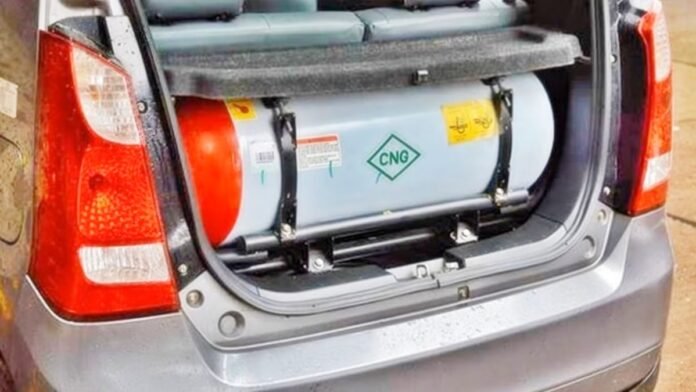
Key Points:
- India’s CNG vehicle sales are projected to reach 1.1 million units by FY25, marking a threefold increase since FY16.
- The number of CNG filling stations has grown from 1,081 in FY16 to over 7,400 in FY25, with a CAGR of 24%.
- Rising fuel prices and government incentives have made CNG a cost-effective and eco-friendly alternative to petrol and diesel.
- Over 30 CNG vehicle models are now available, with increased adoption across passenger, commercial, and even two-wheeler segments.
- Challenges include rising gas prices due to reduced APM gas allocation and competition from electric vehicles (EVs).
New Delhi: India’s CNG vehicle market is experiencing unprecedented growth, with sales expected to hit 1.1 million units by the end of FY25. This surge reflects a threefold increase from just 2.6 million vehicles in FY16, driven by rapid infrastructure expansion, government policies promoting cleaner fuels, and rising fuel prices that have made CNG an attractive alternative.
According to a Crisil report, the total number of CNG vehicles in India will rise to 7.5 million by FY25, supported by a compound annual growth rate (CAGR) of 12%. The government’s push for clean energy and the private sector’s involvement in expanding the refueling network have been instrumental in this transformation.
CNG Infrastructure: A Game-Changer
One of the key drivers of this growth has been the rapid expansion of CNG filling stations across the country. From just 1,081 stations in FY16, the number has skyrocketed to over 7,400 by FY25 a CAGR of 24%. This widespread availability has significantly reduced congestion at stations and improved convenience for users.
The Ministry of Petroleum and Natural Gas has set an ambitious target to expand the network further to 10,000 stations by 2030, ensuring last-mile access even in Tier-II and Tier-III cities. This expansion has also improved operational efficiency for city gas distributors.
CNG Vehicles: Diverse Options Fuel Growth
The availability of over 30 CNG vehicle models across various segments has given consumers more choices than ever before. Automakers like Maruti Suzuki, Tata Motors, and Mahindra are leading the charge by offering factory-fitted CNG variants across their portfolios.
Key trends include:
- Passenger Vehicles: The share of CNG-powered passenger cars is expected to reach 15-16% of total sales by FY25, up from just 5.6% in FY16.
- Commercial Vehicles: Fleet operators are increasingly adopting CNG models due to lower operating costs. Penetration in this segment stands at 10-11%.
- Two-Wheelers: The introduction of CNG-powered scooters marks a new frontier for adoption.
- Three-Wheelers: With a penetration rate of 28-29%, this segment continues to rely heavily on CNG despite growing competition from EVs.
Why Are Consumers Choosing CNG?
Several factors are driving the popularity of CNG vehicles:
- Cost Savings:
- Running costs for CNG vehicles are significantly lower than those for petrol or diesel vehicles. For instance:
- Petrol/Diesel: ₹4.80–₹5.20 per km.
- CNG: ₹2.80 per km.
- This cost advantage is particularly appealing amid rising global crude oil prices.
- Environmental Benefits:
- CNG is a cleaner-burning fuel that reduces carbon emissions and air pollutants compared to traditional fuels.
- Government Incentives:
- Subsidies under schemes like FAME (Faster Adoption and Manufacturing of Hybrid and Electric Vehicles).
- Lower GST rates (28% for CNG vehicles vs. 43% for petrol/diesel cars).
- Road tax exemptions in states like Delhi, Gujarat, and Maharashtra.
- Improved Accessibility:
- The growing network of refueling stations has eased concerns about range anxiety.
Challenges Facing the Sector
Despite its rapid growth, India’s CNG market faces several hurdles:
- Rising Gas Prices:
- The government recently reduced APM gas allocation for city gas distributors (CGDs), leading to increased sourcing costs.
- Some CGDs have raised prices by ₹1–3 per kg since October 2024, with further hikes likely if allocations are cut again.
- Competition from EVs:
- Electric vehicles are gaining traction in urban areas due to advancements in battery technology and government subsidies.
- The three-wheeler segment is particularly vulnerable as EVs become more affordable.
- Policy Uncertainty:
- Industry stakeholders have called for natural gas to be included under GST to stabilize pricing and encourage adoption.
The Road Ahead: Sustaining Momentum
To maintain its growth trajectory, India’s CNG market will need continued investment in infrastructure and supportive policies:
- Expanding the refueling network to underserved regions.
- Offering tax incentives for retrofitting existing vehicles with CNG kits.
- Encouraging public transportation systems like buses and taxis to switch to CNG through priority permits.
Experts believe that while EVs may eventually dominate urban markets, CNG will continue to play a vital role in India’s transition toward cleaner mobility solutions particularly in semi-urban and rural areas where EV infrastructure remains limited.
A Cleaner Future on Wheels
India’s push toward cleaner fuels is reshaping its automotive landscape, with compressed natural gas emerging as a frontrunner alongside electric mobility. As sales approach record levels in FY25, the growing adoption of CNG vehicles underscores their importance as an economical and environmentally friendly alternative.
While challenges like rising costs and regulatory uncertainties persist, the sector’s robust growth reflects strong consumer demand and government commitment. With sustained efforts, India’s vision for greener transportation could soon become a reality driving both economic savings and environmental benefits for millions across the country.











































